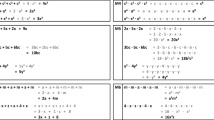Abstract
The development of paired-associate (PA) learning and formal thinking during adolescence was investigated with 78 sixth and tenth grade students. Group-administered tests of formal and divergent thinking were given in the tracked, classroom setting. The augmented PA treatment provided, and the minimal PA treatment did not provide, verbal and pictorial prompts. The percentages of children showing formal thinking increased and converged to the 40% mark for both high and average achievers. While the augmented treatment scores were significantly better than the minimal treatment ones, the evidence was ambiguous concerning whether there was a developmental improvement in spontaneous elaboration skills for high achievers. The hypothesis predicting PA learning to be positively related to divergent thinking, and negatively related to formal thinking, was not supported.
Similar content being viewed by others
References
Adelson, J., and O'Neil, R. P. (1966). Growth of political ideas in adolescence: The sense of community.J. Personal. Soc. Psychol. 4: 295–306.
Case, D., and Collinson, J. M. (1962). The development of formal thinking in verbal comprehension.Brit. J. Educ. Psychol. 57: 103–111.
Dulit, E. (1972). Adolescent thinkingà la Piaget: The formal stage.J. Youth Adolesc. 1: 281–301.
Elkind, D. (1966). Conceptual orientation shifts in children and adolescents.Child Develop. 37: 493–498.
Gagné, R. M. (1965).The Conditions of Learning, Holt, Rinehart and Winston, New York.
Guilford, J. P. (1956). The structure of intellect.Psychol. Bull. 53: 267–293.
Inhelder, B., and Piaget, J. (1958).The Growth of Logical Thinking from Childhood to Adolescence, Basic Books, New York.
Jensen, A. R. (1969). How much can we boost IQ and scholastic achievement?Harvard Educ. Rev. 39: 1–123.
Paivio, A. (1971).Imagery and Verbal Processes, Holt, Rinehart and Winston, New York.
Piaget, J. (1972). Intellectual evolution from adolescence to adulthood.Hum. Develop. 15: 1–12.
Richmond, B. O. (1971). Creative and cognitive abilities of White and Negro children.J. Negro Educ. 23: 111–115.
Rohwer, W. D., Jr. (1971). Learning, race, and school success.Rev. Educ. Res. 41: 191–210.
Rohwer, W. D., Jr. (1973). Elaboration and learning in childhood and adolescence, In H. W. Reese (ed.),Advances in Child Development and Behavior, Academic Press, New York.
Rohwer, W. D., Jr., and Bean, J. P. (1973). Sentence effects and noun-pair learning: A developmental interaction during adolescence.J. Exp. Child Psychol. 15: 521–533.
Ross, R. J. (1973). Some empirical parameters of formal thinking.J. Youth Adolesc. 2: 167–177.
Ross, R. J. (1975). The empirical status of the formal operations.Adolescence (in press).
Shouksmith, G. (1970).Intelligence, Creativity, and Cognitive Style. Wiley, New York.
Tisher, R. P. (1971). A Piagetian questionnaire applied to pupils in a secondary school.Child Develop. 42: 1633–1636.
Torrance, E. P. (1966).Torrance Tests of Creative Thinking: Norms-Technical Manual, Personnel Press, Princeton, N.J.
Wallach, M. A. (1970). Creativity. In Mussen, P. H. (ed.),Carmichael's Manual of Child Psychology, Wiley, New York.
Winer, B. J. (1962).Statistical Principles in Experimental Design, McGraw-Hill, New York.
Author information
Authors and Affiliations
Additional information
Received his Ph.D. in educational psychology from Mississippi State University. Research and writing interests are in cognitive development, mental retardation, and behavior therapy.
Rights and permissions
About this article
Cite this article
Gaylord-Ross, R.J. Paired-associate learning and formal thinking in adolescence. J Youth Adolescence 4, 375–382 (1975). https://doi.org/10.1007/BF01536902
Received:
Issue Date:
DOI: https://doi.org/10.1007/BF01536902




